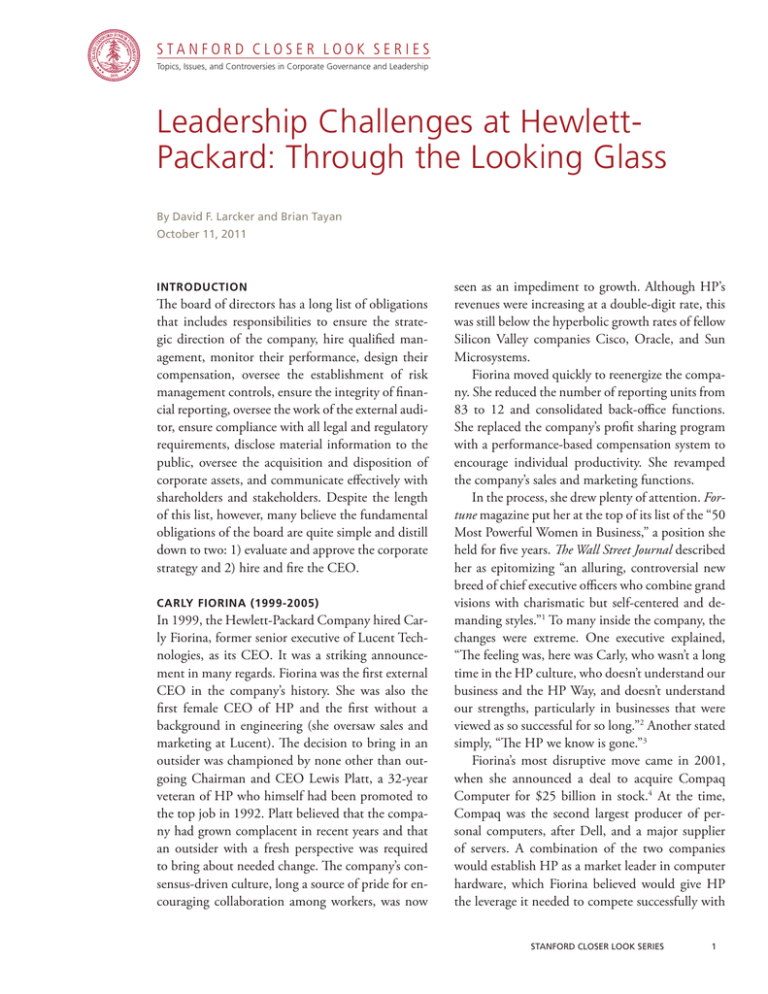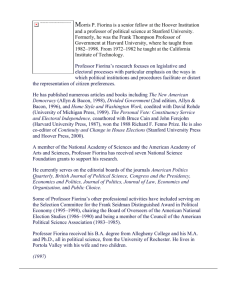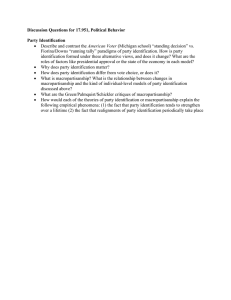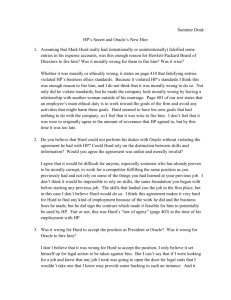
STANFORD CLOSER LOOK SERIES
Topics, Issues, and Controversies in Corporate Governance and Leadership
Leadership Challenges at HewlettPackard: Through the Looking Glass
By David F. Larcker and Brian Tayan
October 11, 2011
Introduction
The board of directors has a long list of obligations
that includes responsibilities to ensure the strategic direction of the company, hire qualified management, monitor their performance, design their
compensation, oversee the establishment of risk
management controls, ensure the integrity of financial reporting, oversee the work of the external auditor, ensure compliance with all legal and regulatory
requirements, disclose material information to the
public, oversee the acquisition and disposition of
corporate assets, and communicate effectively with
shareholders and stakeholders. Despite the length
of this list, however, many believe the fundamental
obligations of the board are quite simple and distill
down to two: 1) evaluate and approve the corporate
strategy and 2) hire and fire the CEO.
Carly Fiorina (1999-2005)
In 1999, the Hewlett-Packard Company hired Carly Fiorina, former senior executive of Lucent Technologies, as its CEO. It was a striking announcement in many regards. Fiorina was the first external
CEO in the company’s history. She was also the
first female CEO of HP and the first without a
background in engineering (she oversaw sales and
marketing at Lucent). The decision to bring in an
outsider was championed by none other than outgoing Chairman and CEO Lewis Platt, a 32-year
veteran of HP who himself had been promoted to
the top job in 1992. Platt believed that the company had grown complacent in recent years and that
an outsider with a fresh perspective was required
to bring about needed change. The company’s consensus-driven culture, long a source of pride for encouraging collaboration among workers, was now
seen as an impediment to growth. Although HP’s
revenues were increasing at a double-digit rate, this
was still below the hyperbolic growth rates of fellow
Silicon Valley companies Cisco, Oracle, and Sun
Microsystems.
Fiorina moved quickly to reenergize the company. She reduced the number of reporting units from
83 to 12 and consolidated back-office functions.
She replaced the company’s profit sharing program
with a performance-based compensation system to
encourage individual productivity. She revamped
the company’s sales and marketing functions.
In the process, she drew plenty of attention. Fortune magazine put her at the top of its list of the “50
Most Powerful Women in Business,” a position she
held for five years. The Wall Street Journal described
her as epitomizing “an alluring, controversial new
breed of chief executive officers who combine grand
visions with charismatic but self-centered and demanding styles.”1 To many inside the company, the
changes were extreme. One executive explained,
“The feeling was, here was Carly, who wasn’t a long
time in the HP culture, who doesn’t understand our
business and the HP Way, and doesn’t understand
our strengths, particularly in businesses that were
viewed as so successful for so long.”2 Another stated
simply, “The HP we know is gone.”3
Fiorina’s most disruptive move came in 2001,
when she announced a deal to acquire Compaq
Computer for $25 billion in stock.4 At the time,
Compaq was the second largest producer of personal computers, after Dell, and a major supplier
of servers. A combination of the two companies
would establish HP as a market leader in computer
hardware, which Fiorina believed would give HP
the leverage it needed to compete successfully with
stanford closer look series
1
Leadership challenges at hewlett-packard: through the looking glass
competitors such as IBM in the enterprise systems
market.
The deal, however, was controversial in two
regards. First, analysts were not convinced that
it made strategic sense. HP was seen as doubling
down on the commoditized business of hardware
manufacturing at a time when many believed it
should focus on higher-margin activities such as
software, services, and printing. According to one
analyst, “Two losers don’t make a winner.”5 As a result, HP stock traded down by 30 percent on the
news (see Exhibit 1). Second, the deal was controversial in that it drew public opposition from Walter Hewlett, son of company co-founder William
Hewlett and a member of the company’s board of
directors. Although he had originally voted with
other board members to approve the deal, he subsequently changed his mind. In a written statement,
Hewlett said that, “Given the lack of stockholder
benefits, I believe the extensive integration risks
associated with this transaction are not worth taking.”6 Shortly thereafter, David Packard Jr., son of
second co-founder David Packard, also came out
in opposition to the deal: “For some time I have
been skeptical about management’s confidence that
it can aggressively reinvent HP culture overnight—
a culture that developed over many years and was
thoroughly tested under all kinds of business conditions. While change is necessary and inevitable,
it does not follow that every innovation is an improvement.”7
Opposition by these two men was significant
not only because they were sons of the company’s
founders but also because the two foundations
which they controlled—the William and Flora
Hewlett Foundation and the David and Lucille
Packard Foundation—together held 15 percent of
HP’s stock. In an escalation of the matter, Walter
Hewlett led a proxy fight to terminate the deal.
The controversy led to a rare, public squabble
between the company and its major shareholders, with HP’s directors joining the fray. Richard
Hackborn, former executive vice president of HP
and board member, defended the deal, stating,
“The board thoroughly analyzed this transaction
and unanimously concluded this is the very best
way to deliver the value our shareholders expect.”8
He admitted, however, to originally sharing Walter Hewlett’s skepticism: “We all had reservations.
None of us was convinced that Compaq was the
exact right answer at the start.” Philip Condit, another director, said that the merger is “certainly not
without risk, but I think the opportunity outweighs
the risk.” Director Robert Knowling said that at first
he was “neutral” to the idea, but over time came to
believe it was an important way to improve HP’s
competitive position. According to board member
George Keyworth, “Very good people have tried to
transform this company through organic growth,
targeted acquisitions and the old way. I believe, this
board believes, we have to take a big step.”9 Following several months of vigorous lobbying of institutional shareholders by Fiorina, the merger was
ultimately approved by a razor-thin margin, with
51.4 percent of shareholders in favor and 48.6 percent opposed.10
The Compaq acquisition, however, did not
prove to be the transformative event that Fiorina
and the board envisioned. HP had forecasted in the
merger prospectus that the PC division of the combined entities would generate an operating margin
of 3.0 percent in 2003. The actual figure came in
at 0.1 percent; in 2004, it was 0.9 percent.11 Following a string of disappointing earnings reports,
the board of directors asked Fiorina for her resignation. Robert Wayman, chief financial officer of HP,
served as interim CEO while the board undertook
a formal search for a successor. Fiorina made the
statement, “While I regret the board and I have
differences about how to execute HP’s strategy, I
respect their decision.”12 She left the company with
a severance package valued at $21 million.
Mark Hurd (2005-2010)
The search for Fiorina’s successor was led by nonexecutive chairman Patricia Dunn and directors
George Keyworth and Thomas Perkins. According
to Dunn, “the board
is firmly committed to
the business strategy that is in place.... Looking
forward, we think the job is very reliant on handson execution, and we think that a new set of capabilities is called for.” When asked whether the
company would consider internal as well as external
candidates, Dunn responded, “We are not ruling
stanford closer look series
2
Leadership challenges at hewlett-packard: through the looking glass
anything out, but we are committed to a very thorough search for the most qualified candidate. We
anticipate that that is an external candidate, but we
don’t know for sure.”13
Ultimately, the company named Mark Hurd,
former CEO of NCR, as chief executive. While
a relative unknown in Silicon Valley, Hurd had a
reputation for strong operations management and
strict cost cutting. Although he had never managed
a company of HP’s size (NCR had $6 billion in revenue at the time, compared to $80 billion at HP),
he had a long-track record of success. He described
his management style in an interview: “I believe
in very engaged management. I personally like to
understand how the businesses work. You’ve heard
the term ‘management by walking around.’ I like to
move through multiple levels of the company and
I like my management to do that. Great companies
have boards, CEOs and management that all have
one script.”14 Separately, he said, “I live by a code
that I got taught very early in my career, that it’s the
company first, the employees second, and you’re
last.”15 The press labeled him “the un-Carly.”
Hurd made aggressive changes to the company’s
operations. He announced a broad restructuring,
including the layoff of 14,500 employees. He reduced management layers and eliminated the corporate sales group, reassigning workers to divisional
groups (PC, printing, and enterprise) so that they
would have deeper knowledge of the products they
sold. To improve accountability, he gave executives
more control over their budgets, and held them
strictly accountable for performance. The company
used the cash flow generated by reduced operating costs to fund a series of acquisitions, primarily
in the software and services space. These included
Mercury Interactive, Peregrine Systems, Palm, and
Electronic Data Systems. The approach paid off.
Over the next five years, HP’s operating margins
increased from 4 percent to 9 percent (see Exhibit
2).
Stability at the company, however, did not last.
In 2006, Patricia Dunn was forced out as chairman of the board. Since 2004, the company had
struggled to contain the release of confidential information regarding boardroom discussions that
was being leaked to the press. This included private
discussion among board members and management regarding strategy, leadership, and corporate
structure. To identify the source of the leaks, Dunn
hired a firm to investigate the matter, which in turn
hired a second firm. The detectives of that firm used
a questionable technique called “pretexting” (pretending to be someone else) to obtain the private
phone records of both HP directors and reporters. Although Dunn was unaware that the technique was being used, she resigned from the board.
George Keyworth was identified as the source of
the leaks and not renominated at the following annual meeting.
In 2010, the company faced another scandal
with the resignation of Mark Hurd. A company
contractor had accused Hurd of sexual harassment.
Although the charges were determined to be unfounded, the investigation revealed that Hurd had
submitted inaccurate expense reports, purportedly
in an attempt to conceal his relationship with the
woman. Director Marc Andreessen called Hurd’s
resignation “a necessary decision.”16 This opinion,
however, was by no means universal. Board members Joel Hyatt and John Joyce advocated that
Hurd remain at the helm until an orderly transition could be arranged. They argued that an abrupt
resignation was “a reckless way to make a change”
that would cause damage to shareholders.17 Others
felt that Hurd had not been entirely forthcoming
with the board and therefore could not be trusted
to continue. The board split six to four. Although
uninvolved, Larry Ellison, CEO of Oracle, expressed his own opinion: “The HP board just made
the worst personnel decision since the idiots on the
Apple board fired Steve Jobs many years ago…. In
losing Mark Hurd, the HP board failed to act in
the best interest of HP’s employees, shareholders,
customers, and partners.”18 Less than one month
later, Ellison hired Hurd to be president of Oracle’s
hardware division. Hurd left HP with a severance
package worth $35 million. CFO Cathie Lesjak
was named CEO on an interim basis.
Léo Apotheker (2010-2011)
The search committee for Hurd’s successor included Marc Andreessen, Lawrence Babbio, John Hammergren, and Joel Hyatt. Unfortunately, the process
stanford closer look series
3
Leadership challenges at hewlett-packard: through the looking glass
was plagued from the outset. First, the dispute over
Mark Hurd’s resignation lingered to such an extent
that it impeded the search committee’s efforts. According to one director, “There were so many hard
feelings. It became difficult to conduct business in a
civil manner.”19 Second, board members were not
in agreement whether an internal or external candidate was preferable. Third, despite the prestige of
the Hewlett-Packard name, several highly talented
external candidates were not interested in the job.
According to some reports, the search committee
approached executives at NCR, IBM, and Microsoft only to be rebuffed because they did not want
to follow in Hurd’s footsteps.
When the company named Léo Apotheker as
CEO in October 2010, the announcement was
greeted with a lackluster response. A native of
Germany, Apotheker was the former CEO of SAP
where he had overseen somewhat unremarkable results. “It’s not something I would have expected,”
said one analyst about the appointment.20 An opinion piece in the Wall Street Journal highlighted “the
unsettling reality that Mr. Apotheker has never truly run his own show, having been SAP’s solo CEO
for less than a year before his abrupt resignation.”21
More striking was the news (not made public for
another year) that not all members of the board
had interviewed, or even met, Apotheker before he
was given the position. One director explained: “I
admit it was highly unusual, but we were just too
exhausted from all the infighting.” According to
another, “among the finalists, he was the best of a
very unattractive group.”22 Shortly thereafter, four
members of the board resigned (Joel Hyatt, John
Joyce, Robert Ryan, and Lucille Salhany). They
were replaced by five new directors: Shumeet Banerji, Gary Reiner, Patricia Russo, Dominique Senequier, and Meg Whitman.
Apotheker’s tenure at HP was brief and disappointing. At first, he committed to continuing the
strategy that Hurd had put in place. Later, he reversed course and announced dramatic changes:
the company would terminate its recent foray into
tablet computing, sell or spin off its PC division,
and purchase business-analytics company Autonomy for $10.25 billion—a price that was ten times
revenue. The news triggered a one-day 20 percent
decline in HP’s stock. Recognizing the tremendous
investor dissatisfaction, the board of directors terminated Apotheker’s employment. He was given a
severance package worth $9.6 million, after only 11
months (see Exhibit 3).
Meg Whitman (2011- )
This time, the board of directors did not form a
search committee or name an interim CEO. Immediately following Apotheker’s resignation, the
board named director Meg Whitman as CEO. Director Ray Lane became executive chairman. Whitman promised to continue the basic strategy of the
company, although she would review the decision
to spin off the PC division.
Many in the investment community were puzzled by the sudden appointment. Although Whitman was well known in Silicon Valley for her tenure
at eBay and her unsuccessful run for the California
governorship, she did not have experience managing a company in the enterprise technology space,
nor had she managed a company of HP’s size. Ray
Lane defended the decision: “If we thought there
was a better choice outside, we would have conducted the search.” When asked whether the board
would make further changes to shore up investor
dissatisfaction, Lane replied: “This is not the board
that was around for pretexting. This is not the board
that fired Mark Hurd. This is not the board that did
everything you want to write about…. It’s just like
open season to write about this board. It’s not this
board, okay?”23
Why This Matters
1.The two primary responsibilities of a board of directors are the approval of the corporate strategy
and the selection of a CEO to refine and execute
that strategy. Has the board of HP settled on a
corporate strategy? Do they understand the skills
and experiences required for a CEO to manage
the company? What are the necessary skills and
experiences to guide HP over the next three to
five years?
2.The hallmark of a well-governed company is a
reliable system for the development of internal
managerial talent. For decades, HP had turned
inside for its chief executive officers. Beginning
stanford closer look series
4
Leadership challenges at hewlett-packard: through the looking glass
with Fiorina that changed. Why has HP since
only appointed outside executives as CEO?
3.In explaining why a company has decided to appoint an external CEO, boards often claim that
there are no insiders who are “ready now.” However, every executive who becomes CEO at one
point had to make the transition having never
done the job before, and it is the responsibility
of the board to mentor him or her through this
process. Is it appropriate for a company to repeatedly view internal candidates as inferior to
external candidates? At some point, shouldn’t
the board look at the “viability” of candidates
rather than whether they are “ready now”?
As a case in point, whereas Platt had travelled by coach, Fiorina
asked HP to purchase a $30 million Gulfstream IV for her use. See
George Anders, “H-P Board Ousts Fiorina as CEO,” The Wall Street
Journal, Feb. 10, 2005.
2
David P. Hamilton, “Soul Saver: Inside Hewlett-Packard, Carly Fiorina Combines Discipline, New-Age Talk,” The Wall Street Journal,
Aug. 22, 2000.
3
Quentin Hardy, “The Cult of Carly,” Forbes, Dec. 13, 1999.
4
The announcement came one year after Fiorina abandoned an $18
billion bid to purchase the consulting arm of Pricewaterhouse, following a precipitous decline in HP stock. In 2002, IBM acquired the
business for $3.5 billion.
5
Molly Williams, “H-P’s Deal for Compaq Has Doubters As Value of
Plan Falls to $20.52 Billion,” The Wall Street Journal, Sep. 5, 2001.
6
Brian Bergstein, “Family, Foundation of HP Co-Founder Oppose
Compaq Deal,” Associated Press, Nov. 6, 2001.
7
Brian Bergstein, “Rebukes from Hewlett-Packard Sons Make Fiorina’s Life Hard,” Associated Press, Nov. 7, 2001.
8
Ibid.
9
Steve Lohr, “It’s the Scion vs. the Board in Merger Fight,” The New
York Times, Feb. 4, 2002.
10
Following the outcome of the vote, Walter Hewlett resigned from
the board. Both the Hewlett and Packard Foundations sold the majority of their holdings in HP stock. See Hewlett-Packard, form 8-K,
filed with the SEC, April 18, 2002.
11
Carol J. Loomis and Oliver Ryan, “Why Carly’s Big Bet is Failing,”
Fortune, Feb. 7, 2005.
12
Pui-Wing Tam, “Fallen Star: HP’s Board Ousts Fiorina as CEO,” The
Wall Street Journal, Feb. 10, 2005.
13
Edited lightly for clarity. “Hewlett-Packard Conference Call-Financial Analysts,” FD (Fair Disclosure) Wire, Feb. 9, 2005.
14
Pui-Wing Tam, “Boss Talk: Hitting the Ground Running—New
CEO of H-P Immerses himself in Studying Company,” The Wall
Street Journal, Apr. 5, 2005.
15
Adam Lashinsky and Doris Burke, “Mark Hurd’s Moment,” Fortune,
Mar. 16, 2009.
16
Ashlee Vance, “Hewlett-Packard Ousts Chief for Hiding Payments
to Friend,” The New York Times, Aug. 7, 2010.
17
Ben Worthen, Justin Scheck and Joann Lublin, “H-P Defends Hasty
Whitman Hire,” The Wall Street Journal, Sep. 23, 2011.
18
Ashlee Vance, “Oracle Chief Faults HP Board for Forcing Hurd
Out,” The New York Times, Aug. 10, 2010.
19
James B. Stewart, “Ouster of Hewlett-Packard CEO is Expected:
Most Voted to Hire Apotheker without Meeting Him,” The New
1
York Times, Sep. 22, 2011.
Ashlee Vance, “Ex-Chief of SAP is Named to Lead H-P,” The New
York Times, Oct. 1, 2010.
21
Rolfe Winkler, “Is Apotheker Right Potion for H-P?” The Wall Street
Journal, Oct. 2, 2010.
22
James B. Stewart, loc. cit.
23
“Hewlett-Packard Names Meg Whitman President and Chief Executive Officer Conference Call,” Sep. 22, 2011. Available at: http://
h30261.www3.hp.com/phoenix.zhtml?c=71087&p=irolirhome.
20
David Larcker is the Morgan Stanley Director of the Center
for Leadership Development and Research at the Stanford
Graduate School of Business and senior faculty member
at the Rock Center for Corporate Governance at Stanford
University. Brian Tayan is a researcher with Stanford’s Center for Leadership Development and Research. They are
coauthors of the books A Real Look at Real World Corporate Governance and Corporate Governance Matters.
The authors would like to thank Michelle E. Gutman for
research assistance in the preparation of these materials.
The Stanford Closer Look Series is a collection of short
case studies that explore topics, issues, and controversies
in corporate governance and leadership. The Closer Look
Series is published by the Center for Leadership Development and Research at the Stanford Graduate School
of Business and the Rock Center for Corporate Governance at Stanford University. For more information, visit:
http://www.gsb.stanford.edu/cldr.
Copyright © 2012 by the Board of Trustees of the Leland
Stanford Junior University. All rights reserved.
stanford closer look series
5
Leadership challenges at hewlett-packard: through the looking glass
Exhibit 1 — Hewlett-Packard: Stock Price History and Selected Events
Fiorina
becomes
CEO
Apotheker
becomes
CEO
$80
HP to
acquire
Compaq
$60
HP to spin
off or sell
PC unit
Hurd
becomes
CEO
$40
Whitman
becomes
CEO
$20
Pretexting
scandal
revealed
$Jan-99
Jan-01
Jan-03
Jan-05
Jan-07
Jan-09
Jan-11
Note: Adjusted for stock splits.
Source: Center for Research in Securities Prices (University of Chicago).
stanford closer look series
6
Leadership challenges at hewlett-packard: through the looking glass
Exhibit 2 — Hewlett-Packard: selected information and board of directors
Year
2000
2001
2002
2003
Revenue ($ mm)
$ 48,782
$ 45,226
$ 56,588
$ 73,067
Earnings ($ mm)
$ 3,697
$ 408
($ 903)
$ 2,539
9.5 %
3.2 %
(1.8 %)
4.0 %
Fiorina
Fiorina
Fiorina
Fiorina
Executive
Carleton Fiorina
Robert Wayman
Executive
Carleton Fiorina
Robert Wayman
Executive
Carleton Fiorina
Michael Capellas
Executive
Carleton Fiorina
Nonexecutive
Philip Condit
Patricia Dunn
Sam Ginn
R. Hackborn
Walter Hewlett
George Keyworth
S. Packard Orr
Nonexecutive
Philip Condit
Patricia Dunn
Sam Ginn
R. Hackborn
Walter Hewlett
George Keyworth
Robert Knowling
Nonexecutive
Lawrence Babbio
Philip Condit
Patricia Dunn
Sam Ginn
R. Hackborn
George Keyworth
Robert Knowling
Sanford Litvack
Thomas Perkins
Lucille Salhany
Nonexecutive
Lawrence Babbio
Philip Condit
Patricia Dunn
Sam Ginn
R. Hackborn
George Keyworth
Robert Knowling
Sanford Litvack
Thomas Perkins
Lucille Salhany
Operating Margin
CEO
Board of Directors
stanford closer look series
7
Leadership challenges at hewlett-packard: through the looking glass
Exhibit 2 — continued
Year
2004
2005
2006
2007
Revenue ($ mm)
$ 79,905
$ 86,696
$ 91,658
$ 104,286
Earnings ($ mm)
$ 3,497
$ 2,398
$ 6,198
$ 7,264
5.3%
4.0 %
7.2 %
8.4 %
Fiorina
Fiorina / Hurd
Hurd
Hurd
Executive
Carleton Fiorina
Executive
Robert Wayman
Executive
Mark Hurd
Robert Wayman
Executive
Mark Hurd
Nonexecutive
Lawrence Babbio
Patricia Dunn
R. Hackborn
George Keyworth
Robert Knowling
Sanford Litvack
Robert Ryan
Lucille Salhany
Nonexecutive
Lawrence Babbio
Patricia Dunn
R. Hackborn
George Keyworth
Robert Knowling
Thomas Perkins
Robert Ryan
Lucille Salhany
Nonexecutive
Lawrence Babbio
Sari Baldauf
Patricia Dunn
R. Hackborn
J. Hammergren
George Keyworth
Thomas Perkins
Robert Ryan
Lucille Salhany
Nonexecutive
Lawrence Babbio
Sari Baldauf
R. Hackborn
J. Hammergren
Robert Ryan
Lucille Salhany
G. Thompson
Operating Margin
CEO
Board of Directors
stanford closer look series
8
Leadership challenges at hewlett-packard: through the looking glass
Exhibit 2 — continued
Year
2008
2009
2010
2011
Revenue ($ mm)
$ 118,364
$ 114,552
$ 126,033
N/A
Earnings ($ mm)
$ 8,329
$ 7,660
$ 8,761
N/A
8.9 %
8.9 %
9.1 %
Hurd
Hurd
Hurd / Apotheker
N/A
Apotheker /
Whitman
Executive
Mark Hurd
Executive
Mark Hurd
Executive
Mark Hurd
Executive
Leo Apotheker
Nonexecutive
Lawrence Babbio
Sari Baldauf
R. Hackborn
J. Hammergren
Joel Hyatt
John Joyce
Robert Ryan
Lucille Salhany
G. Thompson
Nonexecutive
Lawrence Babbio
Sari Baldauf
Rajiv Gupta
J. Hammergren
Joel Hyatt
John Joyce
Robert Ryan
Lucille Salhany
G. Thompson
Nonexecutive
Marc Andreessen
Lawrence Babbio
Sari Baldauf
Rajiv Gupta
J. Hammergren
Joel Hyatt
John Joyce
Robert Ryan
Lucille Salhany
G. Thompson
Nonexecutive
Marc Andreessen
Lawrence Babbio
Sari Baldauf
Shumeet Banerji
Rajiv Gupta
J. Hammergren
Raymond Lane
Gary Reiner
Patricia Russo
D. Senequier
G. Thompson
Meg Whitman
Operating Margin
CEO
Board of Directors
stanford closer look series
9
Leadership challenges at hewlett-packard: through the looking glass
Exhibit 3 — hewlett-packard: Ceo signing bonuses and severances
First Year Compensation
Severance
Carly Fiorina
Salary: $1 million
Signing bonus: $3 million
Annual bonus: $1.25 to $3.75 million
Stock and options: $80 million
Severance: $14 million
Performance bonus: $7.3 million
Accelerated vesting of options
Mark Hurd
Salary: $1.4 million
Signing bonus: $2 million
Annual bonus: $2.8 to $8.4 million
Long-term bonus: $4.2 to $12.6 million
Stock options: $6.9 million
Restricted stock: $8 million
Relocation: $2.75 million
Severance: $12.2 million
Stock options: $8.9 million
Performance units: $12.7 million
Restricted stock: $0.6 million
Léo Apotheker
Salary: $1.2 million
Signing bonus: $4 million
Annual bonus: up to $6 million
Stock and options: $36 million
Relocation and other: $4.6 million
Severance: $7.2 million
Performance bonus: $2.4 million
Accelerated vesting of shares and options
Meg Whitman
Salary: $1 (not million)
Performance bonus: $2.4 million
Stock options: $45.2 million
stanford closer look series
10





